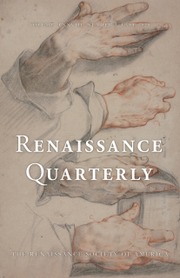Aldo Manuzio (1449/50–1515, name Latinized to Aldus Manutius) has been a perennial favorite of scholars of the Renaissance, who chant his name (along with that of Vespasiano da Bisticci) as a savior of classical literature, or, to understand their more commercial sensibilities, as a purveyor of humanism. Part of the fervor over Aldus has long been driven by bibliophiles, who strive to amass the libelli portatiles. These are among the most prolific, and comparatively affordable, objects of Renaissance material culture available today: specimens of Francesco Griffo’s italic and Greek types, significant editions of humanist texts, special copies printed on vellum (or blue or large paper), and copies still in their original bindings. The books embody the commercialization of classical and humanist texts, as well as several centuries of preservation through scholarly and bibliophilic libraries. Aldus provided a lot of fodder for collectors in his own day and up to the present: Jean Grolier (ca. 1489/90–1565) and Diego Hurtado de Mendoza (1503/04–75) (see Anthony Hobson, Renaissance Book Collecting [1999]), Antoine-Augustin Renouard (1765–1853), George Spencer, Second Earl of Spencer (1758–1834), J. Pierpont Morgan (1837–1913), and, most recently, the collection of T. Kimbell Brooker, bibliophile and philanthropist, whose library of about 1,300 Renaissance books began hitting the auction block at Sotheby’s New York in October 2023, with further sales in the US and Europe expected for several years to come.
Exhibitions devoted to Aldus rarely focus on Aldus. Commemorating the five hundredth anniversary of Aldus’s death in 2015 was Aldus Manutius: A Legacy More Lasting than Bronze at the Grolier Club of New York, an institution devoted to book collectors, where, unsurprisingly, the books took center stage. The following year, the Gallerie dell’Accademia’s Aldo Manuzio: Il Rinascimento di Venezia, to which I was fortunate enough to deliver two of the Morgan’s Aldine editions, highlighted the vibrant artistic world in which Aldus’s press resided. Libraries rather than art museums have long taken the fore in Aldine exhibitions, where Aldus is almost exclusively defined by a humanist text printed in small format with italic type with a dolphin and anchor printer’s mark on the title page.
For all the attention on the books from the Aldine press—and there are a lot of them—Aldus himself often gets lost behind the italic font and enigmatic Hypnerotomachia Poliphili. Margolis’s life of Aldus, Aldus Manutius: The Invention of the Publisher, one of the latest in Reaktion Books’s Renaissance Lives series, helps to turn the spotlight back to the man behind the imprint, and, as the title suggests, argues for Aldus’s role as nascent publisher. For early modern printed books, our modern concept of publishers is not always a clear fit: did the publisher just provide financial backing for the entire printing enterprise, or were books commissioned title by title? Was the publisher the business manager, sitting in the front office, or hawking books but likely not shoulder-to-shoulder with those doing the physical labor of actual printing? Was the publisher an editor, taking a very active role in the pre-printing of the text? Like his predecessor William Caxton, the first English printer—or publisher, following Margolis—Aldus sprinkled bits of autobiography through the prefaces and prologues of his editions, which are mined to understand the intellectual impetus behind the output of the press. Like the fresco by Bernardino Loschi in the Capella di Palazzo dei Pio in Carpi (fig. 8), Margolis crafts a vibrant and detailed portrait of Aldus, charting the intellectual development that bore the fruit of printed books.
The five chapters are not restricted to simple chronology, which makes them a bit more interesting to read, but Margolis keeps the theme of Aldus’s educational program at the center: what he would have brought to his role as tutor to the Pio family and how that impacted his later publishing program. Individual texts and authors abound, but Margolis strikes home through the discussion of the Hypnerotomachia Poliphili, printed in 1499, and the first evidence of Aldus’s interest in the classical emblem that would come to be his trademark: the dolphin and anchor with the Latin motto festina lente. Margolis also spends significant time contextualizing the edition of Catherine of Siena’s Epistolae of 1500, which includes the first printing of the famous italic type—generally speaking, the only reason this work is ever cited. Margolis’s corrective does more to understand Aldus’s publishing program through the Hypnerotomachia Poliphili and Epistolae as integral productions of the press rather than as the isolated one-offs that they are usually considered to be.
In defining Aldus as a publisher, I wish more time had been spent on the Aldine notion of copyright. Griffo’s italic font and the libelli portatiles hit a significant market, and editions were quickly reproduced by printers across Europe. Our modern definition of copyright, much like that of the publisher, is certainly not that of the sixteenth century, and this subject would have benefited from a deeper discussion on the concept of intellectual or bibliographic property. Aldus fought—with very limited success—against other printers reprinting his material. One would think this very idea of copyright would be endemic to what a publisher is, and yet the discussion of it is so minimal in the text that it does not even warrant an entry in the index (which is almost exclusively limited to proper names).
In the end, Margolis provides an exceedingly readable and informative biography of Aldus, which wonderfully augments Lowry’s The World of Aldus Manutius: Business and Scholarship in Renaissance Venice (1979). These two biographies of Aldus’s career and a more book-focused publication, such as the 2015 Grolier Club catalogue for a closer examination of the Aldine imprints, will lead any researcher toward the question: Did Aldus make the books or did the books make Aldus? Margolis definitely seems to argue for the former.


